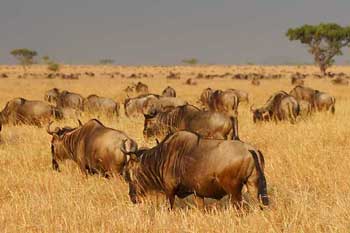
| ||||||||||
|
||||||||||
|
SEE ALL
|
Safari in Tanzania's SerengetiBy Sarah Manners
Tip!
Tanzania's north, including Serengeti, Kilimanjaro, and the adjacent coastline, are more tourist-oriented than the south or west of the country.
Tanzania is truly the safari capital of the world; the word safari is actually Swahili - the native language of Tanzanians. While on a holiday in Tanzania it would be a sin to miss out on the breathtaking natural beauty and the awesome game viewing of the Serengeti. The Magical Plains of the Serengeti
"We walked for miles over burnt out country... Then I saw the green trees of the river, walked two miles more and found myself in paradise." Stewart Edward White when he came upon the Serengeti in 1913. To the Masaai who roamed this gorgeous place it was known as the Siringitu - "the place where the land moves on forever." Anyone visiting the Serengeti will be awestruck by the sheer expanse of the area. Stand still, appreciate the finest qualities of nature and lose yourself in this East African paradise.
Did you Know?
In addition to its famous national parks like Serengeti, Ngorongoro, Lake Manyara and Mt Kiliminanjaro, Tanzania has 17 designated game reserves that are generally not developed for tourism. The Serengeti region encompasses various National Parks and Game reserves in Tanzania including the Serengeti National Park, Maswa Game Reserve, the Loliondo, Grumeti and Ikorongo Controlled Areas, the Ngorongoro Conservation Area and the Maasai Mara National Reserve in Kenya. The Serengeti stretches on for 30,000 km² and is one of the earth's oldest ecosystems. Made up of wide open grassy plains, savannah, wooded grassland, black clay plains, rivers, lakes and swamps, the Serengeti is a diverse and magnificent region. The unique combination of habitats and ecosystems enables the area to support large numbers of different animal and bird species.
The Serengeti National Park The Serengeti National Park is the best-known wildlife sanctuary in the world. With the greatest concentration of plain game in the world, the Serengeti National Park has become a favourite amongst safari enthusiasts world wide. Once you have visited the mystical place you will know why.On a safari in the Serengeti National Park you will see wildebeest, zebra, impala, warthog, gazelle, hyena, lion, leopard, cheetah ,caracal and giraffe to mention but a few. The majestic black-maned lions of Seronera are one of the parks most glorious sights, once hunted and very nearly extinct they can now be seen in prides of up to 20 members.
Tip!
If you're going on safari in Tanzania, it's wise to take a course of anti-malaria tablets, usually starting
before you depart (depends on type of tablet).
The Serengeti Shall Not Die It is not only safari seekers that travel to the Serengeti National Park, the area is an important centre of scientific research. The pioneering work of Dr. Bernhard Grizmek and his Michael concerning aerial surveys of wildlife resulted in the best-selling classic "Serengeti Shall Not Die". The Serengeti Research Institute continues their work, and provides vital information on management and conservation of game parks ecology and ethnology. It is only the rhinos which no longer roam these grassy plains after poaching eradicated them. Conservation efforts in the park have lead to the growth of the wildebeest and buffalo populations which in turn has benefited the predators - lion, cheetah, and hyena. Although conserving the Serengeti's delicate ecosystem is a priority, drought, disease and overgrazing are threats to the survival of this great African region. The Tanzanian government is taking every precaution to ensure the conservation of this amazing natural phenomenon for mankind to enjoy.
Tip!
For visitors to Tanzania, it's not recommended to rely on credit cards as these are only accepted by the larger hotels and some banks.
The Serengeti - A Year Round Destination Visit between the months of December and March to revel in the glory of an African summer. The short, sporadic rains provide relief from the heat and the game viewing is superb. During the rainy season, which lasts from April to June, there tend to be less travellers and the cost of an East African safari is cheaper. Don't be put off by this though as the game viewing opportunities are still excellent. The months from July to November are the busiest when it comes to travel in the Serengeti. Safaris and tours get very busy very quickly so be sure to book in advance to spend your summer holidays exploring this magnificent area.
Did you Know?
Tanganyika, as mainland Tanzania was formerly known, gained independence from Britain in 1961. Undeniably one of the best times to visit the Serengeti is during the annual migration when thousands of wildebeest and zebra make their way from the Serengeti in Tanzania to the Masai Mara in Kenya. As predators follow the wildebeest and zebra closely a migration safari is an ideal opportunity to view lions and other big cats as well as these breathtaking herds. Although the exact timing of the migration changes with each passing year the best time to take in this magnificent phenomenon is between June and August. The herds then usually spend 2 months in the Masai Mara and then begin their long journey back to the glorious Serengeti. Return to Safari Info. |
|||||||||
|
Contact Details: Scotch Macaskill, Dirt Road Traders, Currys Post Road, Howick, KwaZulu-Natal, South Africa. Tel: +27 (0)82 578 2329. Privacy: Your privacy is guaranteed. See our Privacy Policy for more. This site accepts advertising and other forms of compensation - see Disclosure and Advertising for details. Site updated: 2022. Copyright © 2002 - 2022 Scotch Macaskill | ||||||||||
